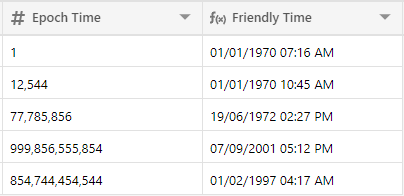

I recommend you to check the Code Snippet down below to test this solution.Ĭonversions from milliseconds Number.prototype. For example, lets say you are in Vancouver, if you are editing a date in July or in December, it can mean you are editing a date in PST or PDT. A UNIX timestamp is a numerical representation of the number of seconds that have elapsed since Januat midnight UTC. Getting the epoch time can be useful to timestamp your readings, etc.

UNIX EPOCH HOW TO
The Number and Date extensions below allow you to show and get dates in the timezone of the timestamps. Learn how to request Epoch time or Unix time using the ESP32 board with Arduino IDE.

Editing a date that is in a different daylight savings time even though in the same timezone can be tricky. If you prefer to resolve timestamps and dates conversions from and to UTC and local time without libraries like moment.js, take a look at the option below.įor applications that use UTC timestamps, you may need to show the date in the browser considering the local timezone and daylight savings when applicable. You don't need to do the d.setUTCMilliseconds(0) step in the accepted answer because the JavaScript Date(value) constructor takes a UTC value in milliseconds (not a local time).Īlso note that you should avoid using the Date(.) constructor that takes a string datetime representation, this is not recommended (see the link above). Careful, the string output here can vary by implementation. When converted to a string, a string conversion of the stored timestamp integer is returned. This site provides the current time in milliseconds elapsed since the UNIX epoch (Jan 1, 1970) as well as in other common formats including local / UTC time comparisons. It can be used to easily format dates and times in specific locales. Its the number of milliseconds / second since a start date. If you want to make this human readable in JavaScript, you need to convert the value to milliseconds, and pass that value into the Date(value) constructor, e.g.: const uni圎pochTimeMS = 1547035195 * 1000 The DateTime data type represents a moment in time using a Unix timestamp. Unix time (also known as POSIX time or Epoch time) is a system for describing instants in time. Therefore, if you have been given a Unix Epoch time value it will probably be in seconds, and will look something like 1547035195. Unix time (also known as Epoch time, POSIX time,seconds since the Epoch,or UNIX Epoch time) is a system for describing a point in time. Unix Epoch time) is nearly always the number of seconds that have expired since 1st Jan 1970 00:00:00 (UTC time), not the number of milliseconds which some of the answers here have implied. Unix time is a date and time representation widely used in computing.


 0 kommentar(er)
0 kommentar(er)
